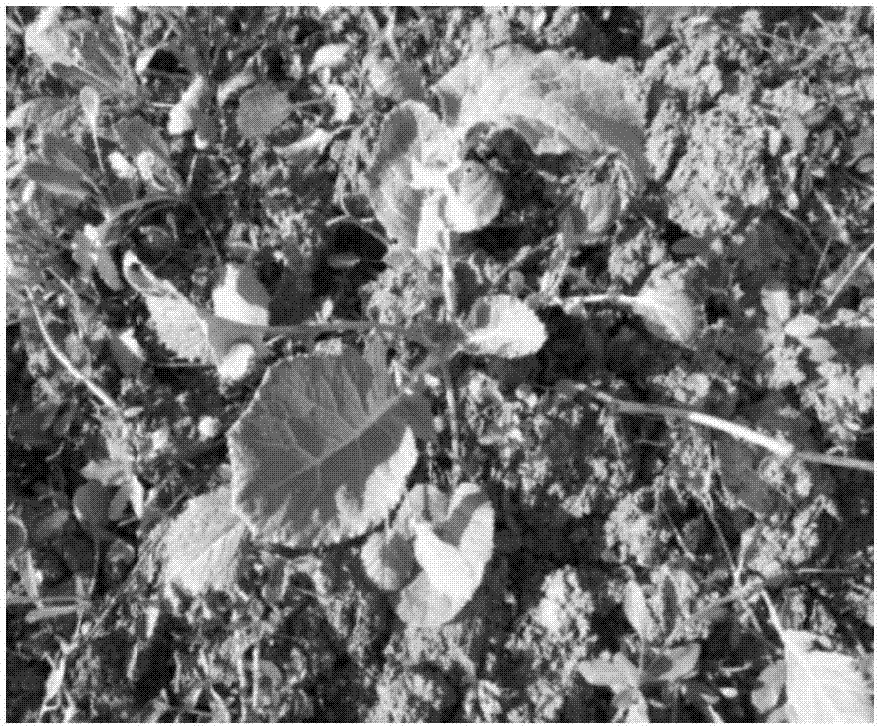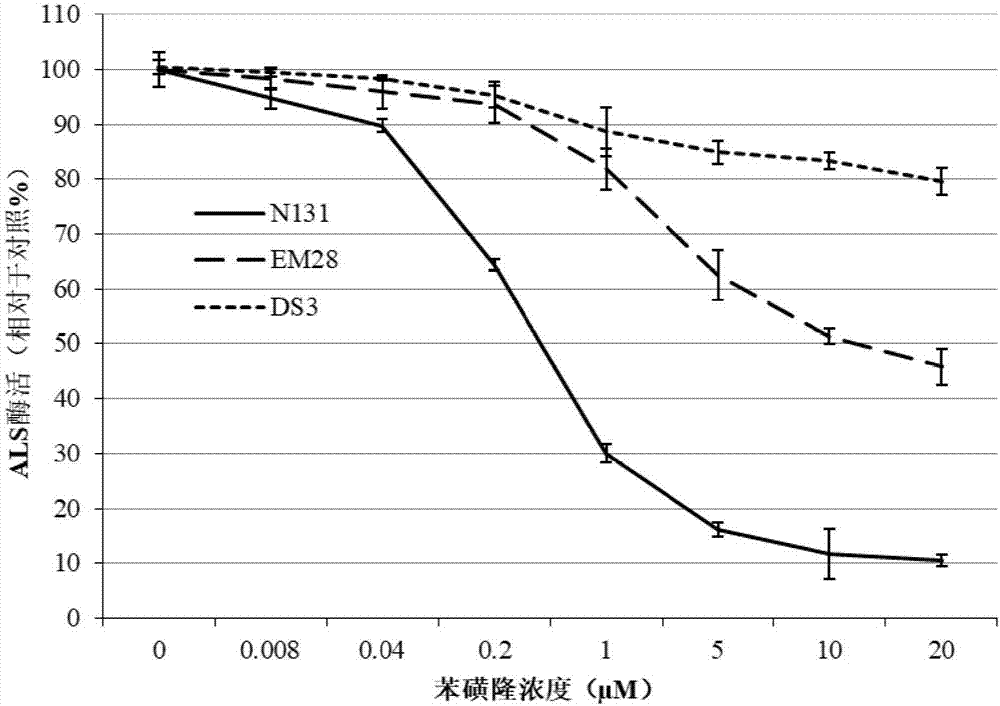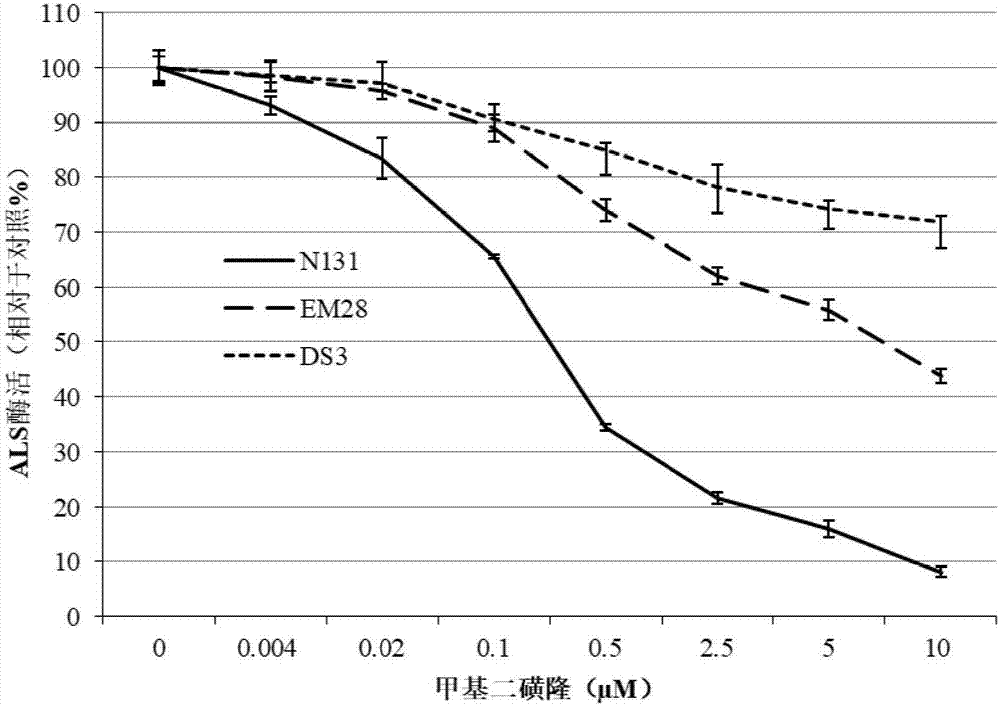Acetolactate synthase mutant protein with herbicide resistance and application thereof
A technology of mutant proteins and proteins, applied in the application, enzyme, transferase and other directions, can solve the problems of complex situation, difficult to predict herbicide resistance in advance, etc., and achieve the effect of improving tolerance
- Summary
- Abstract
- Description
- Claims
- Application Information
AI Technical Summary
Problems solved by technology
Method used
Image
Examples
Embodiment 1
[0036] Example 1: The creation process of the Brassica napus acetolactate synthase mutant with high herbicide resistance
[0037] Before sowing rapeseed, carry out ethyl methanesulfonate (EMS) mutagenesis treatment to wild-type rapeseed line N131 (commonly known and public, see Pu Huiming et al., Jiangsu Agricultural Science Journal, 2010, 26(6): 1432-1434). The process is as follows: 1 day before sowing, put 0.5kg of N131 seeds into a nylon mesh bag, soak in a container filled with clean water for 12 hours, hang the nylon mesh bag on a high place until the water is basically drained, and place it in a 0.4 Treat in %EMS solution (v / v) for 8h, wash the treated seeds with running water for 4h, hang the nylon mesh bag on a high place again and drain the water, immediately sow the seeds (Mo) in a 6× 50m isolation greenhouse. In the spring of that year, after the rapeseed bloomed, it was isolated with a nylon net to keep it pure, and the mature M. 1 seed. At the beginning of Oct...
Embodiment 2
[0039] Example 2: Herbicide Resistance Identification
[0040] The resistance identification test adopts two methods of field identification and greenhouse pot test to identify and evaluate the resistance effect of the resistant mutants EM28 and DS3. The field identification test of rapeseed was carried out in the isolated breeding area of rapeseed of Jiangsu Academy of Agricultural Sciences, and the pot experiment in the greenhouse was carried out in a constant temperature cultivation room. The control material wild type N131 to be treated (commonly known and public, see Pu Huiming etc., Jiangsu Agricultural Science Journal, 2010, 26 (6): 1432-1434), EM28 of the present invention, DS3 seedling emergence grow to 3-4 leaf seedling age, spray respectively Apply different concentrations of SU herbicide tribenuron-methyl (2-[N-(4-methoxy-6-methyl-1,3,5-triazin-2-yl)-N-methylcarbamate Sulfonyl] methyl benzoate) methylsulfuron-methyl (methyl-2 [3- (4, 6- = methoxypyrimidin-2-yl) ...
Embodiment 3
[0044] Embodiment 3: ALS enzyme activity measures in vitro
[0045] Phenotypically, DS3 is highly resistant to SU herbicides, so this herbicide was selected for in vitro enzyme activity assays to compare the differences in herbicide resistance between DS3, EM28 and the original wild-type N131. The determination refers to the method of Singh et al. (Singh BK, et al., Analytical Biochemistry, 1988, 171:173-179). Specifically, take 0.2g of leaf samples respectively, grind and pulverize them with liquid nitrogen in a mortar, add the ground samples into 4.5ml of primary enzyme extract [100mM K 2 HPO 4 , 0.5mM MgCl 2 , 0.5mM Thiamine Pyrophosphate (TPP), 10μM Flavin Adenine Dinucleotide (FAD), 10mM Sodium Pyruvate, 10% (v / v) Glycerol, 1mM Dithiothreitol, 1mM Benzene Sulfonyl fluoride (PMSF), 0.5% (w / v) polyvinylpyrrolidone], centrifuged at 4°C, 12000rpm for 20min. Take the supernatant and add an equal volume of saturated (NH 4 ) 2 SO 4 , placed on ice for 30 minutes, centrifu...
PUM
 Login to View More
Login to View More Abstract
Description
Claims
Application Information
 Login to View More
Login to View More - R&D
- Intellectual Property
- Life Sciences
- Materials
- Tech Scout
- Unparalleled Data Quality
- Higher Quality Content
- 60% Fewer Hallucinations
Browse by: Latest US Patents, China's latest patents, Technical Efficacy Thesaurus, Application Domain, Technology Topic, Popular Technical Reports.
© 2025 PatSnap. All rights reserved.Legal|Privacy policy|Modern Slavery Act Transparency Statement|Sitemap|About US| Contact US: help@patsnap.com



